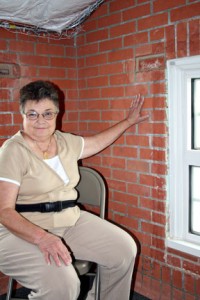Prison turned museum unlocks the past
Alison Schwamkrug
The Signal Staff
For the first time in her life, Annette Williams walked into the building her father worked in for 30 years. Tears filled Williams’ eyes as the sights and smell of the building filled her senses. Walking down the newly constructed hallways, Williams imagined she was walking alongside her father. At some point the stroll overwhelmed Williams, making her dizzy and unable to catch her breath.
Constructed in 1939, the building that now houses the Houston Museum of Natural Science in Sugarland was used as a prison to many first-time felons. After several months of renovating, the city of Houston has brought the building back to life.
Annette Williams, daughter of former warden James Paul, sits in what used to be the solitary confinement room.
“I lived less than 200 yards away and never set foot in this place,” said Annette Williams, daughter of retired warden James Paul, who is now deceased. “I could watch the prisoners from my house hold boxing tournaments in the yard, but I was never allowed inside the prison since I was a girl. Walking inside here for the first time made me break down in tears. I had to sit down and catch my breath. I really feel honored to be here, but I have a few mixed emotions.”
The Houston Museum of Natural Science’s Sugarland branch opened its doors for the first time Oct. 3. The former prison that once confined men away from the world is now unleashing history for men and their families to come explore. Instead of housing inmates, the building now introduces a whole new world to all who enter.
“This building is being preserved and that is what I am thankful for,” Williams said. “I think my dad would be very proud.”
The main unit housed mostly African-American inmates distributed among nine wards called “tanks,” which were located on the first and second floors of the structure. From 1939 to 1968 the prison housed approximately 400 prisoners at a time in these tanks. They were labor prisoners who worked in cotton fields around the city.
“All the architecture sort of speaks of its history,” said Carolyn Summers, vice president for astronomy and physical sciences of HMNS. “All the bricks, concrete and floors were poured by prisoners. It is a prisoner-constructed building.”
Even though the building would not be used as a prison any longer, the city did not want to tear it down.
“The city of Houston wanted a cultural facility,” Summers said. “Telfair community gave the building to Sugarland and Sugarland renovated it, then we moved in.”
The city of Sugarland has grown and developed drastically since the early 2000s.
“This is another indication of growth for the Sugarland area,” said Richard Bush, museum visitor. “If you were to come to Sugarland 20-30 years ago it would have been a bunch of fields and a rundown highway. I think it is a fantastic addition to the Sugarland area. For those who are museum buffs, if you are in to animals, meteorites or gems, this is the place to go.”
The museum’s location is nestled in the middle of Sugarland, making it a convenient location for area residents.
“We live very close; we can basically walk here,” said Ling Li, museum visitor and mother of two. “The convenience of the location makes it so much easier for the kids to come here and learn. They look around and they ask questions to learn all different stuff and we love it. Our favorite exhibit is the planetarium because we like to search for the tiny frogs.”
The museum holds many exhibits such as the planetarium, dinosaur fossils and traveling exhibits. Currently a traveling exhibit called “Narnia” is on display. Based on the film series and C.S. Lewis fictional books, “The Chronicles of Narnia: The Exhibition” allows visitors to tour the scenes of the literary world of Narnia.
“We picked for this museum some of the most fun exhibits,” Summers said. “The frogs are very, very popular because they are hiding in all different places. The science on a sphere is unique to this building. The sphere changes from the blue marble of earth to the different conditions on earth to Jupiter and to Mars. The planetarium, even though it is a miniature, is still true to the experience of being immersed in the dome.”
Future plans for the museum include expanding the building size for upcoming exhibits. The planetarium will be expanded in February when the traveling exhibit “Narnia” leaves.
Even after exploring the exhibits, Williams confessed that although she was proud the prison had been converted to a museum, she was too overwhelmed by emotions to appreciate the current artifacts.
“I don’t think we care enough about the history of Sugarland so this I am proud of; I am extremely happy it is a museum.Although,” Williams said with a laugh, “I haven’t seen it yet.”
Revisiting the museum brings her closer to a past she was never able to explore as a girl. Although some people see dinosaurs and fossils when they visit, Williams still sees apparitions of her father and the prisoners that made the building historic.
Below is a video tour of the prison museum as well as The Signal reporter Ali Schwamkrug’s interview with Annette Williams.



Comments are closed, but trackbacks and pingbacks are open.